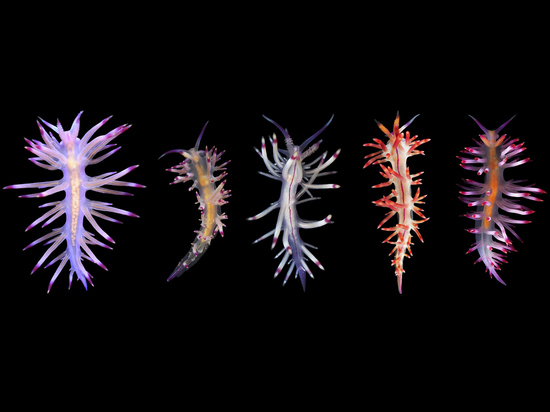
A team of biologists from the IEE RAS and the Faculty of Biology of Moscow State University studied the common tropical nudibranch mollusc Coryphellina rubrolineata.
Molecular genetic analyzes, as well as a study of the external and internal structure of animals, showed that this is not one species, but at least five. As a result, the authors described four new species of nudibranch mollusks that differ in mitochondrial and nuclear genes, as well as body stripes. The study was supported by a grant from the Russian Science Foundation (RSF), the results were published in the journal Diversity.
Molecular genetic methods have allowed scientists to better identify cryptic (similar in appearance, but genetically different) and pseudocryptic (different in appearance, but this becomes clear only after applying genetic methods) species and species complexes. With their spread in taxonomy, the hypothesis of the leading role of geographical barriers and spatial isolation in speciation began to dominate. Often, remote populations of the same species with a wide range began to be divided into several species, based solely on genetic comparison data, which is not always justified. Recent studies in the field of evolution and phylogeny emphasize the great role of the ecological factor in speciation: organisms can diverge into different ecological niches within the same geographical area, acquiring new characters and isolating according to their "way of life."
In modern taxonomy, an integrative approach to the study of species becomes important, when not only individual aspects (morphology, anatomy, ecology, DNA sequences) are evaluated, but also a number of characters in the aggregate. This approach makes it possible not only to describe a new species, but also to understand its evolution, and sometimes even the history of the development of the fauna of an entire region.
The species Coryphellina rubrolineata, which interested Russian scientists, was first described from samples from the Red Sea in 1929, even before the spread of molecular methods. This nudibranch mollusk was later registered in the Mediterranean Sea, Indian and Pacific Oceans. The main identification feature of the species was three bright stripes running along the entire body. However, their color, discontinuity, width, proximity to each other, as well as other features, varied in different individuals.
Employees of the M.V. Lomonosov Moscow State University (Moscow) together with colleagues from the A.N. Severtsov IEE, Russian Academy of Sciences (Moscow), as part of the work of the Russian-Vietnamese Tropical Center, studied individuals of C. rubrolineata from Vietnam. To understand whether this is really one species or still a complex of cryptic or pseudocryptic species, the authors turned to molecular genetic methods.
In total, 28 individuals of Coryphellina were selected in the waters of Vietnam, each of them was photographed, and then cataloged for further research. Based on DNA sequencing data, the authors constructed phylogenetic trees reflecting evolutionary relationships and assessed the degree of differences between the samples. The animals were also studied by microscopic methods, with special attention paid to the reproductive and digestive systems. As a result, it turned out that the objects did not belong to one species, C. rubrolineata, but to five, of which four were first described in this work: Coryphellina pseudolotos, Coryphellina pannae, Coryphellina flamma, and Coryphellina aurora.
“Most of the species we have identified show extremely high divergence, that is, divergence, in mitochondrial genes and, more unusually, in nuclear ones. This may indirectly indicate a level of ancientry. The most significant differences were the signs of coloration and, in particular, the type of red stripes: in some species they are intermittent, in others they are extended along the entire length of the body, in others they are completely absent,” explains Irina Ekimova, project manager under the RSF grant and the first author of the study, Ph.D. Biological Sciences, Senior Researcher, Faculty of Biology, Moscow State University. - Their general coloration is also different, although it can vary quite a lot within the same species. At the same time, the signs of the internal structure of the new species are very conservative, which is probably due to similar food preferences and breeding strategies.”
From such revisions — discoveries of new species within a group or, conversely, combinations of several into one — evolutionary trees of small and then large groups of organisms are built. If we look at these data through the prism of space and time - that is, where, when and how new species “budded off”, scientists will be able to reconstruct the entire history of the fauna of the regions, going beyond the objects they study. Nudibranch mollusks, due to different reproductive strategies and dispersal abilities, are a convenient model object in this respect.
Information and photos provided by the press service of Moscow State University. In the photo: Collage with photographs of Coryphellina lotos (left) and four new described species: (left to right) C. pseudolotos, C. pannae, C. flamma, C. aurora / Source: Irina Ekimova, Faculty of Biology, Moscow State University
Related materials:
MK.ru: "Metropolitan zoologists have found four new species of mollusks in one"
ИА Красная весна: "Biologists of Moscow State University and the Russian Academy of
Sciences have identified new species of tropical mollusks"
Planet today: "Zoologists took a closer look at tropical molluscs and described four new
species"
